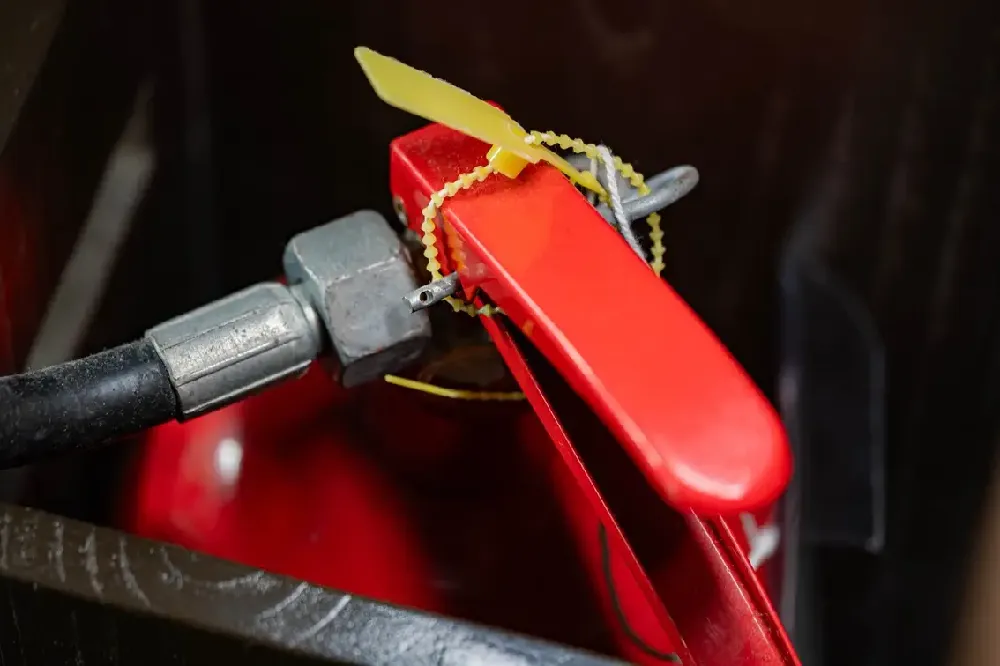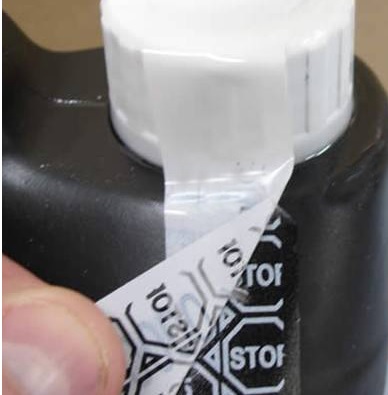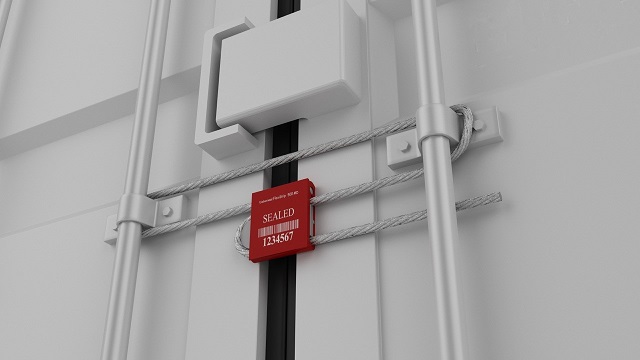Security seals provide are essential tools in safeguarding goods, ensuring integrity, and preventing unauthorised access across various industries. In this guide, we will dive into what security seals are, their different types, applications, and their significance in today's security landscape.
Defining Security Seals

A security seal is a tamper-evident device designed to secure cargo, equipment or assets requiring protection. Sealed enclosures can take many forms – including cargo contained within sacks, truck trailers, sea cargo containers and tote boxes. Once applied, seals provide clear evidence if access has been attempted or compromised. Unlike locks, security seals are typically single-use and must be broken to be removed, leaving behind physical evidence of unauthorised entry.
Padlocks, on the other hand, are reusable security devices that require keys to open and close, providing a physical barrier but do not always provide clear evidence of tampering. Similarly, cable ties are a simple, low-cost option often used to secure items, but they are not truly tamper-evident and can be easily undone or replaced, making them less reliable for security purposes compared to tamper-evident devices.
Two Functions of Security Seals
Security seals, when used properly as part of a wider security protocol, serve two key functions.
Firstly, they provide indelible visual evidence of tampering. They show physical evidence if interfered with, such as tell-tale signs of breakage or changes of appearance like 'blushing' on surface of plastic, indicating physical manipulation of the seal.
Secondly, security seals serve an access control function, reducing the occurrence of unauthorised access of sealed enclosures. They do this above all by their mere presence – well-placed seals serve as a psychological deterrence, simply by making individuals think twice about the consequences. Beyond this, barrier seals (described below) provide a physical barrier to entry, acting like a specialised single-use lock which requires cutting tools to open.
Types and Applications of Security Seals
 |  |
Security seals are physical devices used to prevent unauthorised access, provide tamper evidence, and protect valuable goods during storage or transit. Understanding the different types of seals and their specific uses across industries is essential when choosing the right one. From lightweight plastic seals to heavy-duty cable and bolt seals, each type is designed to meet varying levels of security and practical requirements.
It is worth noting that security seals don’t come in any one particular form – they can range from simple void security labels or stickers suitable for application on flat enclosures such as pallets or carton seams, all the way up to heavy-duty metal construction container barrier seals... …As long as it is a tamper-evident device which controls access to enclosures, then it is a security seal.
Plastic Seals
Plastic security seals are lightweight, cost-effective, and ideal for low to medium-security applications. They’re commonly used in the retail, logistics, and courier sectors to seal containers, sacks, roll cages, and storage boxes. Plastic pull tight seals are particularly useful where a snug fit is needed, for example when securing mail sacks, first aid kits, and storage crates. Their tamper-evident design makes it immediately clear if a seal has been removed or interfered with, helping prevent theft or loss in transit.
Indicative Seals
Indicative seals are designed to show clear evidence of tampering rather than provide high physical resistance. They’re typically used in postal services, domestic haulage, and utilities for applications like sealing sacks, bags, fire extinguishers, and water meters. These seals are easily broken or cut using simple tools, and are ideal when the priority is visibility of access rather than security strength. Versions include filmic security labels and tapes which are simply peeled away but immediately demonstrate unauthorised access through clear visual void indicators.
Metal Seals
Metal security seals offer a stronger and more durable option, often favoured for high-value or international shipments. These barrier seals are commonly used in customs, shipping, and industrial environments where a higher level of resistance to tampering is required. Cable seals, bolt seals, metal strap seals and padlock seals can all provide a robust barrier to entry, making them well suited for container security and for protecting access points and storage units that require both clear identification and strong resistance to tampering.
Cable Seals
Cable seals combine flexibility with strength and are ideal for securing truck doors, tankers, valves, and shipping containers. Their adjustable design allows them to fit many applications while providing high-security protection. Cable seals are tamper-evident and require cutting tools for removal, making them suitable for industries that need both resilience and adaptability in harsh conditions.
Bolt Seals
Bolt seals (also known as barrier security seals) are high security seals primarily used for shipping containers and international freight. These seals meet meet the ISO17712:2013 ‘H’ ‘High-Security’ classification and are recognised by customs authorities worldwide. Requiring bolt cutters for removal, they serve as a visible and physical deterrent against tampering or unauthorised access. Their use is standard in global logistics and transportation sectors to meet regulatory compliance and safeguard valuable cargo.
Industry Applications
Logistics and Transportation: Cable and bolt seals are widely used to secure trailers, cargo containers, and freight, providing strong barriers and clear tamper evidence. Barrier seals also play a critical role in maintaining chain-of-custody and preventing unauthorised entry during global transit. Plastic indicative seals are also used where tamper-evidence is required - whilst these types of seals can be opened by anyone, they effectively alert users to security breaches within their supply chain.
Retail and E-commerce: Plastic seals, security labels and tapes help protect goods in transit and storage, particularly for high-turnover operations. Their low cost and tamper-evident design make them ideal for use with postal bags, courier bags and delivery cartons.
Healthcare and Pharmaceuticals: Plastic pull through seals are used to secure clinical waste bags, storage units, medicine containers, chemical drums and access-controlled areas. Tamper-evident features help maintain regulatory compliance and ensure product integrity.
Utilities and Metering: Tamper-evident seals are applied to meters and control panels to prevent unauthorised use and protect against fraud. These are especially useful in water, gas, and electricity services where reliable readings and system integrity are essential.
Postal and Courier Services: Indicative seals are applied to postal sacks, containers, and equipment to ensure secure and traceable delivery of items. Their visibility and ease of application make them suitable for high-volume operations.
Best Practices for Security Seal Use
To maximise the effectiveness of security seals, it’s essential to follow industry best practices. Start by selecting the right security seal for your specific application considering the level of security required, the type of container or asset being protected, and any relevant industry standards, such as ISO security seals for international shipments. Using tamper evident seals with features such as sequential numbering or barcodes enhances traceability and accountability, making it easier to track and verify each seal throughout its lifecycle.
Proper application is key, so ensure that each seal is applied in a way that makes any tampering immediately visible. Integrate security seals with other security measures, such as access control systems and surveillance, to create a comprehensive approach to asset protection. Regularly inspect seals for signs of tampering or damage, and replace any compromised seals promptly to maintain the integrity of your security protocols.
Compliance with international customs standards and regulations is also crucial, especially when shipping cargo across borders. Adhering to these standards not only ensures smooth transit but also protects your company from potential legal or financial repercussions. By following these best practices, companies can effectively use security seals to protect containers, cargo, and valuable assets from theft and unauthorised access, safeguarding their operations and reputation.
Why Choose Universeal?
.webp)
At Universeal, we understand the importance of reliable security solutions tailored to your specific needs. Whether you require high-security seals for international shipping or cost-effective plastic seals for retail applications, our expert team can guide you to the perfect product. With a wide range of security seals that meet industry standards, we help protect your assets, streamline compliance, and reduce the risk of tampering. Contact us today to discuss your requirements and find out how Universeal can support your security needs.
Summary
Security seals play a vital role across industries by safeguarding assets, ensuring compliance, and providing clear tamper evidence. By selecting the right type of seal and working with a trusted provider like Universeal, you can strengthen your security measures with confidence and peace of mind.
This article is the first of three, looking at how security seals can fit within your wider security protocols. View Series below...
- What are Security Seals? Understanding Types, Uses, and Importance
- Choosing the Best Security Seal for the Job
- Security Protocols: Making Security Seals work for you


